How to budget
Introduction
Now that the new year is approaching, we have a perfect time for getting our personal finances in order.
In this post I go over how I use google sheets to set up a simple yet effective budget system. I would like to emphasize the system, it's not just a tool to keep track of expenses but also a way of thinking.
I did not use any template to build it. I just used my use case and a couple of guidelines to create it. It has been working well for me and I would like to share to maybe inspire you as well.
Here is the basic structure of it,
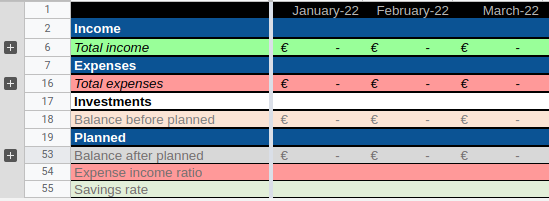
It has three main sections, dark blue background. Income and expenses are the basic from a standard budget. The planned section is an extra which I will explain later.
Budget guidelines
My guidelines for the budgeting are basically simple & easy. I'm lazy, and I want something sustainable for the long run.
How it works
It is easy: income - expenses, done. The part of income and expense is standard. One particularity of the expenses that might not be intuitive is that investments are in it.
The planned section I got the idea from YNAB. I have never used YNAB but I know they have something in this sense. My idea is simply separate part of the budget now as a "virtual expense" to use as "extra income" later. I will try to explain this better with some schemes;
Regular expenses
Regular expenses are kept in a separate spreadsheet with a simple layout. Just date, category and value (and observation in case a want to remember later). I like to separate this data input to avoid clutter. The spreadsheet is accessible with my cellphone, so I can register expenses on it.
Then in the budget statement I collect the categories for the month with this sumifs formula.
=SUMIFS(log!$C$2:$C$344, # sum range
log!$B$2:$B$344,budget!$A9, # match a criteria
log!$A$2:$A$344,"<="&L$1, # within a month
log!$A$2:$A$344,">"&EDATE(L$1, -1)) # within the month
Update: Since I learn the query function in google sheets I have been using it whenever I find a chance.
The formula now looks like,
QUERY(log!$A:$C,"select sum(C) where B contains '"&$A9&"' and month(A)+1="&MONTH(K$1)&" and year(A)="&YEAR(K$1)&" label sum(C) ''")
Just sum when it matches the category and check the month and year. Very clean.
Looks like this:
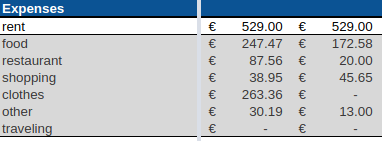
Grey cells are automatic and white cell manually added.
Planned expenses
Let's say in June you have a surplus, so you decide to save up for a that big purchase you plan doing later. Then, the budget for this month would look like this,
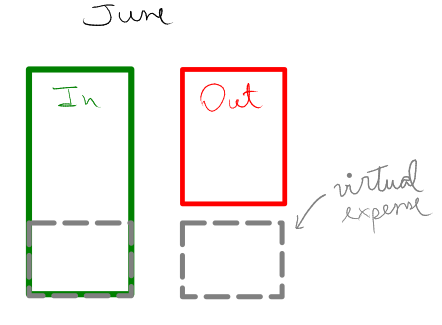
Now in July, you decided to purchase that expensive thing you have been dreaming about it. The virtual expense now turns into an "extra income".
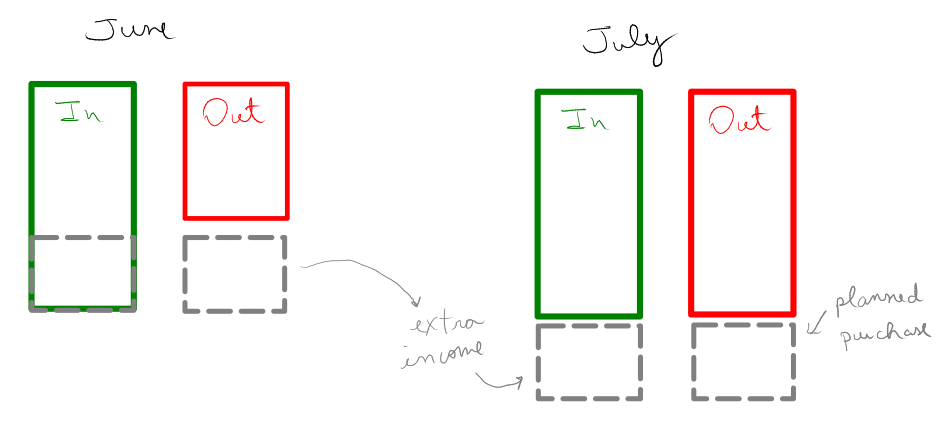
Honestly, feels good to have an expense not affecting your usual budget. Let's see how it looks in the spreadsheet, in January:
Entries:
- got 1000;
- spent 500 and invested 250;
- 250 was directed to this special thing that costs 1000;
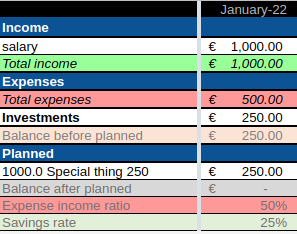
Repeating this for the next 4 months, when we want to finally make that big purchase. We then entry the "extra income" to help with our purchase. With this, our monthly budget is green and balanced even with a expense larger than our income for the month. Our saving rate still intact as well.
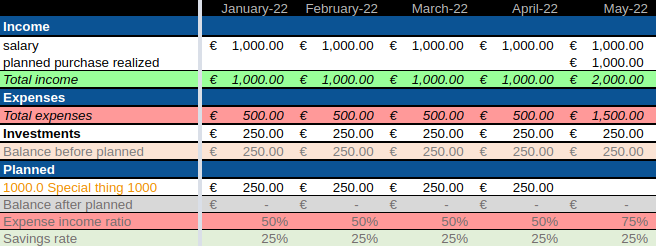
Conclusion
With those concepts of "virtual expense" and "extra income" one can easily keep track of planned purchases. The budget tool is simple with just bare bone functionality, nothing complex. It is concise, every month in a column which makes easier to see evolution through time. And finally, I think is sustainable for the long run.